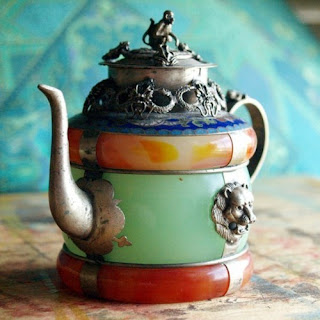Or, questions to ask yourself when you're trying to downsize.
If you haven't already, read
Part 1 of how to reorganize a kitchen. It's a fundamental step, and it's super easy!
In theory, at least...
When it gets down to reality, though, it can be kind of tough to let go of some items, even if you rarely use them. So here is a progression of questions to ask yourself when you're standing there with a widget in your hand, wondering whether to keep it or give it away.
Let's start with the practical:
- When was the last time I used this?
- What are the odds that I'll use it within the next six months? Name a percentage.
If you can't remember the last time you used it, then you're not keeping it for a practical reason, you're keeping it for an emotional reason. (More on that in a minute.) If you won't use the thing more than once or twice a year, then you might want to question whether you really need it. Exceptions may be made for special holiday traditions that you and your family truly treasure. For example, we always have homemade waffles with mixed-berry sauce on Thanksgiving and Christmas mornings, and once-in-a-blue-moon just because.
My kids (now in college) love that and look forward to it. It makes no sense for that waffle maker to be taking up space in my kitchen for the 363 days that it doesn't get used. Still, it's a beloved tradition, so I pack the thing away in a box in the basement, and pull it out just when we'll want it.
(No, that's not my photo, and no, I don't put sprigs of mint on our Christmas morning waffles. Or anything else, ever. But the sauce looks kinda like ours. Thanks, Taste of Home.)
Now, to identify those things that you don't really use, but are keeping for an emotional reason. Try asking...
- Does it represent a happy memory? Or does just seeing it make you smile?
- Would you feel guilty getting rid of it because Great Aunt Sadie brought it over from the old country?
- Does it represent me being someone I wish I were, but really am not?
If you're just keeping it because you have some happiness attached to it,
and if you have room for it, keep it! Put it out on display (not buried in a drawer) and enjoy it. If you don't have room for it, however, consider getting a nice photo taken of it, and frame a small picture of it to keep in your kitchen where you'll see it often.
If you're keeping a thing just because it belonged to some ancestor, let me share some advice that an older relative gave me years ago which was incredibly freeing. I was debating what to do with an old ornate table that had been my grandma's, but that I wasn't particularly fond of. This woman -- who collected antiques and was very into family history -- said, "If you don't love it, don't keep it. You have other ways of remembering your grandma." Which is absolutely right.
Okay, how about those things that represent some past hopes you had, or someone you once wanted to be. Say, cookie cutters that you envisioned sharing with your kids at Christmas cookie-baking time -- only to discover that they had no interest and you had no patience! Let it go! Be free! You have other ways to count your success as a baker, wife, husband, mother, etc.
I recently let my sewing machine go for this reason. I used to sew pretty often, and I still think of projects I'd like to do, but honestly, I really only go at it about once every three years. I had to come to grips with the fact that I am no longer A Person Who Sews. But that's okay. I am now A Person Who Works From Home, and A Person Who Volunteers, and A Person Who Walks the Dog (Almost) Every Day, which I wasn't before, so it's not like I'm becoming nothing by giving up this one aspect of myself.
Still having a tough time letting go of some things? Here are a couple more questions to ask yourself:
- How tough or expensive would it be to replace this if I really do need one again in the future?
- Is there someone else who might get more use and enjoyment out of this than I am?
In regards to that last question, I learned an important lesson from three people: Oswald Chambers, and my parents. In his classic book of devotions,
My Utmost for His Highest, Chambers talks about keeping things for ourselves for so long, they become spiritual dry rot. He was speaking of spiritual blessings, but I think it applies to material things, too. When disassembling my parents' belongings for their estate sale, there were so many things they held on to for so long that the stuff had become worthless. If they'd given away that TV or those clothes or that sofa when they first realized they didn't need them, someone else might have enjoyed and been blessed by a few years' use of the goods. Instead, the stuff sat in storage until it was so outdated or decayed that it was only fodder for the dumpster. Now, I try to look at items I'm keeping but not using -- whether kitchen gear, clothing, or books -- and ask, "Am I depriving someone else of the use and joy of this item by hoarding it for myself?"
I hope these questions are helpful to you. Next installment we'll get down to sorting and packing!











